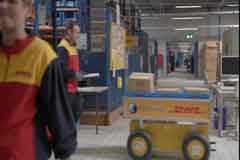| |
|
| |
|
 |
Supply
Chain by the Numbers |
| |
|
| |
- Oct. 3, 2019 -
|
| |
|
| |
|
| |
|
| |
The GM Strike and Electric Cars; Labor Share of US Income Continues to Fall; US Manufacturing Index Falls to Lowerst Level in a Decade; DHL Plans Big Technology Spend |
| |
|
| |
| |
| |
| |
40% |
|
That is how much fewer labor hours that are needed to assemble an electric motor and battery than a traditional internal-combustion engine and transmission. That according to recent analysis from the consultants at Alix Partners, as cited in an article on Bloomberg this week on the on-going GM labor strike involving some 35,000 UAW workers. The impact on jobs from what is expected to be a rapidly growing share of sales of electric cars by GM and other manufacturers is a key issue in the negotiations. "There's a potential for our jobs to be gone - they don't need us anymore," said Tim Walbolt, president of the UAW local representing workers at a Fiat Chrysler transmission components plant near Toledo, Ohio. "It scares us." Jennifer Kelly, the union's research director, said during a collective-bargaining conference in Detroit earlier this year that "Electric, to me, is where the real risk is to our membership." It's almost certain to carry over from the UAW's talks with GM to negotiations with Detroit's other automakers. Ford has estimated electric cars will require 30% fewer hours of labor per vehicle and 50% less factory floor space.
|
|
|
| |
| |
|
|
|
That was the level of the September Purchasing Managers Index from the Institute for Supply Management – more than two points below the 50 mark that separates US manufacturing expansion from contraction, and below 50 for the second consecutive month. It was also the lowest mark since June 2009 – the very bottom of the great recession. The indices for New Orders, Production, Employees and more were also below the key 50 mark. So that's all bad news for the economy – but maybe it's just a slowdown, not a recession. In its regular economic forecast, the Federal Reserve Bank of Atlanta last week downgraded its forecast for Q3 US real GDP growth to 1.9% - not very strong, but far away from the actual economic contraction that characterizes recessions. But the number was down from its previous forecast of 2.1% growth.
|
| |
| |
|
| |
| |
$2.2 Billion |
 |
That's how 3PL giant DHL plans to spend on technology though 2025, the company announced this week. Of course, DHL sees much of that investment going to provide additional capabilities for ecommerce fulfillment. Investment areas will include more warehouse automation and robotics, applying data analytics to optimize delivery routes, and improving volume forecasting, the company said. Of course, DHL is hardly the only logistics company betting big on technology. C.H. Robinson Worldwide, the large freight broker, said last month it plans to spend $1 billion over the next five years to bulk up its technology. And XPO Logistics recently said it has increased its capital spending from $504 million in 2017 to a planned $650 million this year, with much of it going toward technology.
|
| |
| |
| |
| |
| |
|
|
|
| |
 |
 |
| |
|
|
| |